What Is Geometry Used For
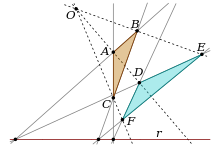
Geometry (from Ancient Greek γεωμετρία ( geōmetría ) 'land measurement'; from γῆ ( gê ) 'globe, land', and μέτρον ( métron ) 'a measure') is, with arithmetic, i of the oldest branches of mathematics. It is concerned with backdrop of space that are related with distance, shape, size, and relative position of figures.[one] A mathematician who works in the field of geometry is called a geometer.
Until the 19th century, geometry was almost exclusively devoted to Euclidean geometry,[a] which includes the notions of indicate, line, plane, distance, bending, surface, and curve, as key concepts.[2]
During the 19th century several discoveries enlarged dramatically the telescopic of geometry. 1 of the oldest such discoveries is Gauss' Theorema Egregium ("remarkable theorem") that asserts roughly that the Gaussian curvature of a surface is independent from any specific embedding in a Euclidean space. This implies that surfaces tin be studied intrinsically, that is, as stand-alone spaces, and has been expanded into the theory of manifolds and Riemannian geometry.
Later in the 19th century, it appeared that geometries without the parallel postulate (non-Euclidean geometries) can exist adult without introducing any contradiction. The geometry that underlies general relativity is a famous application of not-Euclidean geometry.
Since then, the scope of geometry has been profoundly expanded, and the field has been split in many subfields that depend on the underlying methods—differential geometry, algebraic geometry, computational geometry, algebraic topology, detached geometry (also known every bit combinatorial geometry), etc.—or on the properties of Euclidean spaces that are disregarded—projective geometry that consider only alignment of points simply non distance and parallelism, affine geometry that omits the concept of angle and distance, finite geometry that omits continuity, and others.
Originally developed to model the physical world, geometry has applications in virtually all sciences, and likewise in art, compages, and other activities that are related to graphics.[iii] Geometry also has applications in areas of mathematics that are apparently unrelated. For example, methods of algebraic geometry are key in Wiles's proof of Fermat's Final Theorem, a trouble that was stated in terms of elementary arithmetic, and remained unsolved for several centuries.
History

A European and an Arab practicing geometry in the 15th century
The earliest recorded beginnings of geometry can be traced to ancient Mesopotamia and Egypt in the 2nd millennium BC.[four] [5] Early on geometry was a drove of empirically discovered principles apropos lengths, angles, areas, and volumes, which were developed to see some practical demand in surveying, structure, astronomy, and diverse crafts. The earliest known texts on geometry are the Egyptian Rhind Papyrus (2000–1800 BC) and Moscow Papyrus (c. 1890 BC), and the Babylonian clay tablets, such every bit Plimpton 322 (1900 BC). For instance, the Moscow Papyrus gives a formula for calculating the volume of a truncated pyramid, or frustum.[six] Later dirt tablets (350–50 BC) demonstrate that Babylonian astronomers implemented trapezoid procedures for computing Jupiter's position and movement inside fourth dimension-velocity space. These geometric procedures predictable the Oxford Calculators, including the mean speed theorem, by 14 centuries.[7] South of Arab republic of egypt the ancient Nubians established a system of geometry including early versions of lord's day clocks.[8] [9]
In the 7th century BC, the Greek mathematician Thales of Miletus used geometry to solve problems such every bit calculating the pinnacle of pyramids and the distance of ships from the shore. He is credited with the offset utilise of deductive reasoning applied to geometry, by deriving four corollaries to Thales' theorem.[10] Pythagoras established the Pythagorean School, which is credited with the first proof of the Pythagorean theorem,[11] though the statement of the theorem has a long history.[12] [13] Eudoxus (408–c. 355 BC) developed the method of burnout, which allowed the calculation of areas and volumes of curvilinear figures,[14] every bit well as a theory of ratios that avoided the problem of incommensurable magnitudes, which enabled subsequent geometers to make significant advances. Around 300 BC, geometry was revolutionized past Euclid, whose Elements, widely considered the well-nigh successful and influential textbook of all time,[fifteen] introduced mathematical rigor through the axiomatic method and is the primeval example of the format all the same used in mathematics today, that of definition, precept, theorem, and proof. Although most of the contents of the Elements were already known, Euclid arranged them into a single, coherent logical framework.[xvi] The Elements was known to all educated people in the West until the middle of the 20th century and its contents are still taught in geometry classes today.[17] Archimedes (c. 287–212 BC) of Syracuse used the method of exhaustion to summate the expanse under the arc of a parabola with the summation of an infinite series, and gave remarkably accurate approximations of pi.[18] He also studied the screw bearing his name and obtained formulas for the volumes of surfaces of revolution.
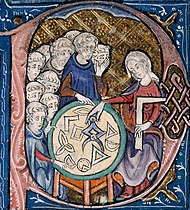
Adult female instruction geometry. Illustration at the offset of a medieval translation of Euclid's Elements, (c. 1310).
Indian mathematicians also made many important contributions in geometry. The Satapatha Brahmana (tertiary century BC) contains rules for ritual geometric constructions that are similar to the Sulba Sutras.[nineteen] Co-ordinate to (Hayashi 2005, p. 363), the Śulba Sūtras contain "the earliest extant verbal expression of the Pythagorean Theorem in the world, although it had already been known to the Old Babylonians. They contain lists of Pythagorean triples,[20] which are particular cases of Diophantine equations.[21] In the Bakhshali manuscript, there is a handful of geometric problems (including problems about volumes of irregular solids). The Bakhshali manuscript also "employs a decimal identify value system with a dot for cipher."[22] Aryabhata'south Aryabhatiya (499) includes the computation of areas and volumes. Brahmagupta wrote his astronomical work Brāhma Sphuṭa Siddhānta in 628. Chapter 12, containing 66 Sanskrit verses, was divided into two sections: "basic operations" (including cube roots, fractions, ratio and proportion, and barter) and "practical mathematics" (including mixture, mathematical series, airplane figures, stacking bricks, sawing of timber, and piling of grain).[23] In the latter department, he stated his famous theorem on the diagonals of a cyclic quadrilateral. Chapter 12 also included a formula for the area of a cyclic quadrilateral (a generalization of Heron'south formula), besides equally a complete clarification of rational triangles (i.e. triangles with rational sides and rational areas).[23]
In the Center Ages, mathematics in medieval Islam contributed to the evolution of geometry, especially algebraic geometry.[24] [25] Al-Mahani (b. 853) conceived the idea of reducing geometrical problems such as duplicating the cube to problems in algebra.[26] Thābit ibn Qurra (known as Thebit in Latin) (836–901) dealt with arithmetic operations applied to ratios of geometrical quantities, and contributed to the development of analytic geometry.[27] Omar Khayyám (1048–1131) found geometric solutions to cubic equations.[28] The theorems of Ibn al-Haytham (Alhazen), Omar Khayyam and Nasir al-Din al-Tusi on quadrilaterals, including the Lambert quadrilateral and Saccheri quadrilateral, were early results in hyperbolic geometry, and along with their culling postulates, such equally Playfair's axiom, these works had a considerable influence on the evolution of non-Euclidean geometry amidst later European geometers, including Witelo (c. 1230–c. 1314), Gersonides (1288–1344), Alfonso, John Wallis, and Giovanni Girolamo Saccheri.[ dubious ] [29]
In the early 17th century, there were two important developments in geometry. The offset was the creation of analytic geometry, or geometry with coordinates and equations, by René Descartes (1596–1650) and Pierre de Fermat (1601–1665).[30] This was a necessary precursor to the development of calculus and a precise quantitative science of physics.[31] The 2nd geometric development of this menstruum was the systematic study of projective geometry past Girard Desargues (1591–1661).[32] Projective geometry studies properties of shapes which are unchanged nether projections and sections, especially equally they relate to creative perspective.[33]
2 developments in geometry in the 19th century changed the way it had been studied previously.[34] These were the discovery of not-Euclidean geometries by Nikolai Ivanovich Lobachevsky, János Bolyai and Carl Friedrich Gauss and of the conception of symmetry every bit the central consideration in the Erlangen Programme of Felix Klein (which generalized the Euclidean and non-Euclidean geometries). 2 of the primary geometers of the fourth dimension were Bernhard Riemann (1826–1866), working primarily with tools from mathematical analysis, and introducing the Riemann surface, and Henri Poincaré, the founder of algebraic topology and the geometric theory of dynamical systems. Equally a consequence of these major changes in the conception of geometry, the concept of "space" became something rich and varied, and the natural background for theories as different as complex analysis and classical mechanics.[35]
Primary concepts
The following are some of the most of import concepts in geometry.[2] [36] [37]
Axioms

Euclid took an abstract approach to geometry in his Elements,[38] ane of the virtually influential books ever written.[39] Euclid introduced certain axioms, or postulates, expressing primary or self-axiomatic properties of points, lines, and planes.[40] He proceeded to rigorously deduce other properties by mathematical reasoning. The characteristic feature of Euclid's approach to geometry was its rigor, and it has come up to exist known as axiomatic or constructed geometry.[41] At the start of the 19th century, the discovery of not-Euclidean geometries by Nikolai Ivanovich Lobachevsky (1792–1856), János Bolyai (1802–1860), Carl Friedrich Gauss (1777–1855) and others[42] led to a revival of interest in this subject field, and in the 20th century, David Hilbert (1862–1943) employed axiomatic reasoning in an attempt to provide a modern foundation of geometry.[43]
Objects
Points
Points are more often than not considered fundamental objects for building geometry. They may exist defined by the properties that thay must have, as in Euclid's definition as "that which has no part",[44] or in constructed geometry. In mod mathematics, they are generally defined as elements of a set called space, which is itself axiomatically divers.
With these modern definitions, every geometric shape is defined as a set of points; this is non the instance in constructed geometry, where a line is some other central object that is not viewed equally the set of the points through which information technology passes.
Yet, there has modern geometries, in which points are not archaic objects, or fifty-fifty without points.[45] [46] 1 of the oldest such geometries is Whitehead's point-complimentary geometry, formulated by Alfred Northward Whitehead in 1919–1920.
Lines
Euclid described a line as "breadthless length" which "lies equally with respect to the points on itself".[44] In modern mathematics, given the multitude of geometries, the concept of a line is closely tied to the way the geometry is described. For instance, in analytic geometry, a line in the plane is often defined as the set of points whose coordinates satisfy a given linear equation,[47] but in a more abstruse setting, such as incidence geometry, a line may be an independent object, distinct from the prepare of points which lie on it.[48] In differential geometry, a geodesic is a generalization of the notion of a line to curved spaces.[49]
Planes
In Euclidean geometry a airplane is a flat, ii-dimensional surface that extends infinitely;[44] the definitions for other types of geometries are generalizations of that. Planes are used in many areas of geometry. For case, planes can exist studied equally a topological surface without reference to distances or angles;[l] information technology can be studied as an affine space, where collinearity and ratios tin can be studied but not distances;[51] it can be studied as the circuitous plane using techniques of complex analysis;[52] and and so on.
Angles
Euclid defines a plane angle every bit the inclination to each other, in a plane, of two lines which see each other, and practice not lie direct with respect to each other.[44] In modern terms, an angle is the figure formed by ii rays, called the sides of the angle, sharing a mutual endpoint, called the vertex of the angle.[53]

Acute (a), obtuse (b), and straight (c) angles. The acute and obtuse angles are also known as oblique angles.
In Euclidean geometry, angles are used to study polygons and triangles, as well every bit forming an object of study in their own right.[44] The study of the angles of a triangle or of angles in a unit circle forms the ground of trigonometry.[54]
In differential geometry and calculus, the angles between plane curves or space curves or surfaces can be calculated using the derivative.[55] [56]
Curves
A bend is a 1-dimensional object that may be straight (like a line) or not; curves in 2-dimensional space are chosen airplane curves and those in 3-dimensional space are chosen infinite curves.[57]
In topology, a curve is divers by a function from an interval of the real numbers to another space.[fifty] In differential geometry, the same definition is used, merely the defining part is required to exist differentiable [58] Algebraic geometry studies algebraic curves, which are divers as algebraic varieties of dimension one.[59]
Surfaces

A sphere is a surface that can be defined parametrically (by ten = r sin θ cos φ, y = r sin θ sin φ, z = r cos θ) or implicitly (by x 2 + y 2 + z 2 − r 2 = 0.)
A surface is a ii-dimensional object, such equally a sphere or paraboloid.[60] In differential geometry[58] and topology,[l] surfaces are described by two-dimensional 'patches' (or neighborhoods) that are assembled past diffeomorphisms or homeomorphisms, respectively. In algebraic geometry, surfaces are described by polynomial equations.[59]
Manifolds
A manifold is a generalization of the concepts of curve and surface. In topology, a manifold is a topological space where every point has a neighborhood that is homeomorphic to Euclidean space.[50] In differential geometry, a differentiable manifold is a infinite where each neighborhood is diffeomorphic to Euclidean space.[58]
Manifolds are used extensively in physics, including in general relativity and cord theory.[61]
Length, area, and volume
Length, area, and volume draw the size or extent of an object in one dimension, 2 dimension, and iii dimensions respectively.[62]
In Euclidean geometry and analytic geometry, the length of a line segment can ofttimes be calculated by the Pythagorean theorem.[63]
Area and book can be defined as cardinal quantities separate from length, or they can be described and calculated in terms of lengths in a plane or 3-dimensional space.[62] Mathematicians accept found many explicit formulas for area and formulas for volume of various geometric objects. In calculus, expanse and volume can be defined in terms of integrals, such as the Riemann integral[64] or the Lebesgue integral.[65]
Metrics and measures
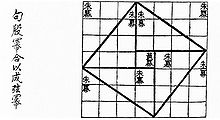
The concept of length or distance can be generalized, leading to the idea of metrics.[66] For example, the Euclidean metric measures the altitude between points in the Euclidean airplane, while the hyperbolic metric measures the distance in the hyperbolic aeroplane. Other of import examples of metrics include the Lorentz metric of special relativity and the semi-Riemannian metrics of general relativity.[67]
In a different direction, the concepts of length, expanse and volume are extended by measure out theory, which studies methods of assigning a size or measure out to sets, where the measures follow rules similar to those of classical area and book.[68]
Congruence and similarity
Congruence and similarity are concepts that describe when two shapes take like characteristics.[69] In Euclidean geometry, similarity is used to describe objects that take the same shape, while congruence is used to describe objects that are the same in both size and shape.[70] Hilbert, in his work on creating a more rigorous foundation for geometry, treated congruence every bit an undefined term whose backdrop are divers by axioms.
Congruence and similarity are generalized in transformation geometry, which studies the backdrop of geometric objects that are preserved by different kinds of transformations.[71]
Compass and straightedge constructions
Classical geometers paid special attention to amalgam geometric objects that had been described in some other fashion. Classically, the only instruments used in most geometric constructions are the compass and straightedge.[b] Likewise, every structure had to be complete in a finite number of steps. However, some problems turned out to be difficult or impossible to solve by these means lone, and ingenious constructions using neusis, parabolas and other curves, or mechanical devices, were plant.
Dimension

Where the traditional geometry allowed dimensions 1 (a line), ii (a plane) and 3 (our ambient globe conceived of equally 3-dimensional infinite), mathematicians and physicists have used higher dimensions for nearly two centuries.[72] One example of a mathematical use for higher dimensions is the configuration space of a physical system, which has a dimension equal to the system'south degrees of freedom. For instance, the configuration of a screw can be described by five coordinates.[73]
In full general topology, the concept of dimension has been extended from natural numbers, to infinite dimension (Hilbert spaces, for example) and positive real numbers (in fractal geometry).[74] In algebraic geometry, the dimension of an algebraic variety has received a number of obviously different definitions, which are all equivalent in the most common cases.[75]
Symmetry

The theme of symmetry in geometry is nearly as former as the science of geometry itself.[76] Symmetric shapes such as the circle, regular polygons and platonic solids held deep significance for many ancient philosophers[77] and were investigated in particular before the fourth dimension of Euclid.[40] Symmetric patterns occur in nature and were artistically rendered in a multitude of forms, including the graphics of Leonardo da Vinci, M. C. Escher, and others.[78] In the second half of the 19th century, the relationship between symmetry and geometry came under intense scrutiny. Felix Klein's Erlangen program proclaimed that, in a very precise sense, symmetry, expressed via the notion of a transformation group, determines what geometry is.[79] Symmetry in classical Euclidean geometry is represented by congruences and rigid motions, whereas in projective geometry an analogous role is played by collineations, geometric transformations that take straight lines into straight lines.[lxxx] However information technology was in the new geometries of Bolyai and Lobachevsky, Riemann, Clifford and Klein, and Sophus Lie that Klein's idea to 'define a geometry via its symmetry grouping' establish its inspiration.[81] Both discrete and continuous symmetries play prominent roles in geometry, the onetime in topology and geometric group theory,[82] [83] the latter in Lie theory and Riemannian geometry.[84] [85]
A different blazon of symmetry is the principle of duality in projective geometry, among other fields. This meta-phenomenon can roughly be described every bit follows: in any theorem, exchange betoken with aeroplane, join with meet, lies in with contains, and the result is an equally true theorem.[86] A similar and closely related form of duality exists between a vector space and its dual space.[87]
Contemporary geometry
Euclidean geometry
Euclidean geometry is geometry in its classical sense.[88] As it models the space of the physical world, it is used in many scientific areas, such as mechanics, astronomy, crystallography,[89] and many technical fields, such as engineering,[90] architecture,[91] geodesy,[92] aerodynamics,[93] and navigation.[94] The mandatory educational curriculum of the majority of nations includes the study of Euclidean concepts such equally points, lines, planes, angles, triangles, congruence, similarity, solid figures, circles, and analytic geometry.[36]
Differential geometry
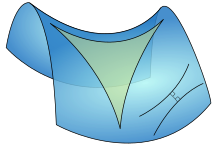
Differential geometry uses techniques of calculus and linear algebra to study problems in geometry.[95] Information technology has applications in physics,[96] econometrics,[97] and bioinformatics,[98] among others.
In item, differential geometry is of importance to mathematical physics due to Albert Einstein's full general relativity postulation that the universe is curved.[99] Differential geometry can either be intrinsic (significant that the spaces it considers are shine manifolds whose geometric structure is governed past a Riemannian metric, which determines how distances are measured most each point) or extrinsic (where the object nether study is a part of some ambient flat Euclidean infinite).[100]
Non-Euclidean geometry
Euclidean geometry was not the only historical form of geometry studied. Spherical geometry has long been used by astronomers, astrologers, and navigators.[101]
Immanuel Kant argued that there is only one, absolute, geometry, which is known to be true a priori by an inner faculty of mind: Euclidean geometry was synthetic a priori.[102] This view was at start somewhat challenged by thinkers such as Saccheri, so finally overturned by the revolutionary discovery of non-Euclidean geometry in the works of Bolyai, Lobachevsky, and Gauss (who never published his theory).[103] They demonstrated that ordinary Euclidean space is but one possibility for development of geometry. A broad vision of the subject of geometry was then expressed by Riemann in his 1867 inauguration lecture Über die Hypothesen, welche der Geometrie zu Grunde liegen (On the hypotheses on which geometry is based),[104] published only afterward his decease. Riemann's new thought of space proved crucial in Albert Einstein'southward general relativity theory. Riemannian geometry, which considers very general spaces in which the notion of length is defined, is a mainstay of modernistic geometry.[81]
Topology

Topology is the field concerned with the properties of continuous mappings,[105] and can be considered a generalization of Euclidean geometry.[106] In exercise, topology oftentimes means dealing with large-scale backdrop of spaces, such as connectedness and firmness.[fifty]
The field of topology, which saw massive development in the 20th century, is in a technical sense a type of transformation geometry, in which transformations are homeomorphisms.[107] This has oftentimes been expressed in the form of the saying 'topology is safe-sheet geometry'. Subfields of topology include geometric topology, differential topology, algebraic topology and general topology.[108]
Algebraic geometry

The field of algebraic geometry developed from the Cartesian geometry of co-ordinates.[109] It underwent periodic periods of growth, accompanied by the creation and study of projective geometry, birational geometry, algebraic varieties, and commutative algebra, amid other topics.[110] From the tardily 1950s through the mid-1970s information technology had undergone major foundational development, largely due to work of Jean-Pierre Serre and Alexander Grothendieck.[110] This led to the introduction of schemes and greater emphasis on topological methods, including diverse cohomology theories. Ane of seven Millennium Prize problems, the Hodge conjecture, is a question in algebraic geometry.[111] Wiles' proof of Fermat'due south Last Theorem uses advanced methods of algebraic geometry for solving a long-continuing problem of number theory.
In full general, algebraic geometry studies geometry through the use of concepts in commutative algebra such as multivariate polynomials.[112] It has applications in many areas, including cryptography[113] and string theory.[114]
Complex geometry
Complex geometry studies the nature of geometric structures modelled on, or arising out of, the complex plane.[115] [116] [117] Circuitous geometry lies at the intersection of differential geometry, algebraic geometry, and analysis of several complex variables, and has establish applications to string theory and mirror symmetry.[118]
Complex geometry first appeared as a singled-out expanse of study in the work of Bernhard Riemann in his written report of Riemann surfaces.[119] [120] [121] Work in the spirit of Riemann was carried out by the Italian school of algebraic geometry in the early 1900s. Contemporary treatment of complex geometry began with the piece of work of Jean-Pierre Serre, who introduced the concept of sheaves to the subject, and illuminated the relations between circuitous geometry and algebraic geometry.[122] [123] The primary objects of study in complex geometry are complex manifolds, complex algebraic varieties, and complex analytic varieties, and holomorphic vector bundles and coherent sheaves over these spaces. Special examples of spaces studied in complex geometry include Riemann surfaces, and Calabi–Yau manifolds, and these spaces notice uses in string theory. In particular, worldsheets of strings are modelled by Riemann surfaces, and superstring theory predicts that the extra 6 dimensions of 10 dimensional spacetime may be modelled by Calabi–Yau manifolds.
Discrete geometry
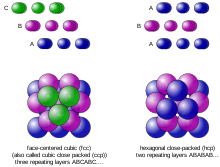
Discrete geometry is a subject that has close connections with convex geometry.[124] [125] [126] It is concerned mainly with questions of relative position of simple geometric objects, such as points, lines and circles. Examples include the study of sphere packings, triangulations, the Kneser-Poulsen conjecture, etc.[127] [128] It shares many methods and principles with combinatorics.
Computational geometry
Computational geometry deals with algorithms and their implementations for manipulating geometrical objects. Important problems historically have included the travelling salesman problem, minimum spanning trees, subconscious-line removal, and linear programming.[129]
Although being a young area of geometry, information technology has many applications in computer vision, image processing, figurer-aided blueprint, medical imaging, etc.[130]
Geometric group theory

The Cayley graph of the free group on two generators a and b
Geometric group theory uses big-scale geometric techniques to study finitely generated groups.[131] It is closely connected to depression-dimensional topology, such as in Grigori Perelman'southward proof of the Geometrization conjecture, which included the proof of the Poincaré theorize, a Millennium Prize Problem.[132]
Geometric group theory often revolves around the Cayley graph, which is a geometric representation of a grouping. Other important topics include quasi-isometries, Gromov-hyperbolic groups, and correct angled Artin groups.[131] [133]
Convex geometry
Convex geometry investigates convex shapes in the Euclidean space and its more abstruse analogues, often using techniques of real assay and discrete mathematics.[134] It has close connections to convex assay, optimization and functional analysis and important applications in number theory.
Convex geometry dates dorsum to artifact.[134] Archimedes gave the first known precise definition of convexity. The isoperimetric trouble, a recurring concept in convex geometry, was studied by the Greeks equally well, including Zenodorus. Archimedes, Plato, Euclid, and after Kepler and Coxeter all studied convex polytopes and their properties. From the 19th century on, mathematicians take studied other areas of convex mathematics, including higher-dimensional polytopes, volume and surface area of convex bodies, Gaussian curvature, algorithms, tilings and lattices.
Applications
Geometry has found applications in many fields, some of which are described beneath.
Art
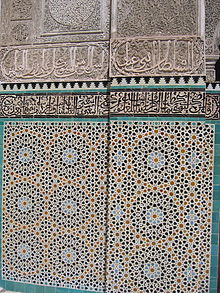
Bou Inania Madrasa, Fes, Morocco, zellige mosaic tiles forming elaborate geometric tessellations
Mathematics and art are related in a variety of ways. For instance, the theory of perspective showed that in that location is more to geometry than just the metric properties of figures: perspective is the origin of projective geometry.[135]
Artists have long used concepts of proportion in blueprint. Vitruvius developed a complicated theory of ideal proportions for the human effigy.[136] These concepts have been used and adapted by artists from Michelangelo to modernistic comic book artists.[137]
The golden ratio is a particular proportion that has had a controversial role in fine art. Often claimed to exist the most aesthetically pleasing ratio of lengths, information technology is frequently stated to be incorporated into famous works of art, though the about reliable and unambiguous examples were made deliberately by artists aware of this legend.[138]
Tilings, or tessellations, have been used in fine art throughout history. Islamic art makes frequent utilize of tessellations, every bit did the art of G. C. Escher.[139] Escher'southward work likewise made apply of hyperbolic geometry.
Cézanne advanced the theory that all images can be congenital up from the sphere, the cone, and the cylinder. This is still used in art theory today, although the exact list of shapes varies from author to author.[140] [141]
Architecture
Geometry has many applications in compages. In fact, information technology has been said that geometry lies at the core of architectural design.[142] [143] Applications of geometry to architecture include the use of projective geometry to create forced perspective,[144] the employ of conic sections in amalgam domes and similar objects,[91] the use of tessellations,[91] and the use of symmetry.[91]
Physics
The field of astronomy, especially as it relates to mapping the positions of stars and planets on the celestial sphere and describing the relationship between movements of celestial bodies, take served as an important source of geometric problems throughout history.[145]
Riemannian geometry and pseudo-Riemannian geometry are used in general relativity.[146] String theory makes use of several variants of geometry,[147] every bit does quantum information theory.[148]
Other fields of mathematics
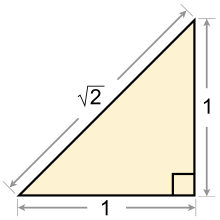
The Pythagoreans discovered that the sides of a triangle could have incommensurable lengths.
Calculus was strongly influenced by geometry.[30] For case, the introduction of coordinates by René Descartes and the concurrent developments of algebra marked a new phase for geometry, since geometric figures such as plane curves could at present be represented analytically in the class of functions and equations. This played a primal role in the emergence of infinitesimal calculus in the 17th century. Analytic geometry continues to exist a mainstay of pre-calculus and calculus curriculum.[149] [150]
Some other important area of application is number theory.[151] In ancient Greece the Pythagoreans considered the role of numbers in geometry. However, the discovery of incommensurable lengths contradicted their philosophical views.[152] Since the 19th century, geometry has been used for solving issues in number theory, for example through the geometry of numbers or, more than recently, scheme theory, which is used in Wiles'south proof of Fermat's Last Theorem.[153]
See also
Lists
- Listing of geometers
- Category:Algebraic geometers
- Category:Differential geometers
- Category:Geometers
- Category:Topologists
- List of formulas in elementary geometry
- List of geometry topics
- List of important publications in geometry
- Lists of mathematics topics
- Descriptive geometry
- Finite geometry
- Flatland, a book written by Edwin Abbott Abbott about two- and three-dimensional space, to understand the concept of iv dimensions
- List of interactive geometry software
Other fields
- Molecular geometry
Notes
- ^ Until the 19th century, geometry was dominated by the assumption that all geometric constructions were Euclidean. In the 19th century and later, this was challenged by the development of hyperbolic geometry past Lobachevsky and other non-Euclidean geometries by Gauss and others. Information technology was and so realised that implicitly non-Euclidean geometry had appeared throughout history, including the piece of work of Desargues in the 17th century, all the fashion dorsum to the implicit employ of spherical geometry to empathise the Earth geodesy and to navigate the oceans since antiquity.
- ^ The aboriginal Greeks had some constructions using other instruments.
- ^ Vincenzo De Risi (2015). Mathematizing Infinite: The Objects of Geometry from Antiquity to the Early Modern Age. Birkhäuser. pp. 1–. ISBN978-3-319-12102-iv.
- ^ a b Tabak, John (2014). Geometry: the linguistic communication of space and form. Infobase Publishing. p. xiv. ISBN978-0-8160-4953-0.
- ^ Walter A. Meyer (2006). Geometry and Its Applications. Elsevier. ISBN978-0-08-047803-half dozen.
- ^ J. Friberg, "Methods and traditions of Babylonian mathematics. Plimpton 322, Pythagorean triples, and the Babylonian triangle parameter equations", Historia Mathematica, eight, 1981, pp. 277–318.
- ^ Neugebauer, Otto (1969) [1957]. "Chap. Four Egyptian Mathematics and Astronomy". The Exact Sciences in Antiquity (two ed.). Dover Publications. pp. 71–96. ISBN978-0-486-22332-two. .
- ^ (Boyer 1991, "Egypt" p. 19)
- ^ Ossendrijver, Mathieu (29 January 2016). "Aboriginal Babylonian astronomers calculated Jupiter's position from the expanse under a time-velocity graph". Scientific discipline. 351 (6272): 482–484. Bibcode:2016Sci...351..482O. doi:ten.1126/science.aad8085. PMID 26823423. S2CID 206644971.
- ^ Depuydt, Leo (1 Jan 1998). "Gnomons at Meroë and Early on Trigonometry". The Journal of Egyptian Archeology. 84: 171–180. doi:10.2307/3822211. JSTOR 3822211.
- ^ Slayman, Andrew (27 May 1998). "Neolithic Skywatchers". Archaeology Magazine Archive. Archived from the original on 5 June 2011. Retrieved 17 Apr 2011.
- ^ (Boyer 1991, "Ionia and the Pythagoreans" p. 43)
- ^ Eves, Howard, An Introduction to the History of Mathematics, Saunders, 1990, ISBN 0-03-029558-0.
- ^ Kurt Von Fritz (1945). "The Discovery of Incommensurability by Hippasus of Metapontum". The Register of Mathematics.
- ^ James R. Choike (1980). "The Pentagram and the Discovery of an Irrational Number". The Two-Year College Mathematics Journal.
- ^ (Boyer 1991, "The Age of Plato and Aristotle" p. 92)
- ^ (Boyer 1991, "Euclid of Alexandria" p. 119)
- ^ (Boyer 1991, "Euclid of Alexandria" p. 104)
- ^ Howard Eves, An Introduction to the History of Mathematics, Saunders, 1990, ISBN 0-03-029558-0 p. 141: "No piece of work, except The Bible, has been more than widely used...."
- ^ O'Connor, J.J.; Robertson, E.F. (February 1996). "A history of calculus". University of St Andrews. Archived from the original on 15 July 2007. Retrieved 7 August 2007.
- ^ Staal, Frits (1999). "Greek and Vedic Geometry". Journal of Indian Philosophy. 27 (i–2): 105–127. doi:x.1023/A:1004364417713. S2CID 170894641.
- ^ Pythagorean triples are triples of integers with the property: . Thus, , , etc.
- ^ (Cooke 2005, p. 198): "The arithmetic content of the Śulva Sūtras consists of rules for finding Pythagorean triples such every bit (three, iv, 5), (five, 12, 13), (8, 15, 17), and (12, 35, 37). Information technology is non sure what practical employ these arithmetics rules had. The best conjecture is that they were part of religious ritual. A Hindu dwelling house was required to have three fires burning at three different altars. The three altars were to be of different shapes, simply all three were to take the same area. These weather led to certain "Diophantine" problems, a particular case of which is the generation of Pythagorean triples, so as to brand 1 square integer equal to the sum of ii others."
- ^ (Hayashi 2005, p. 371)
- ^ a b (Hayashi 2003, pp. 121–122)
- ^ R. Rashed (1994), The development of Arabic mathematics: betwixt arithmetics and algebra, p. 35 London
- ^ (Boyer 1991, "The Standard arabic Hegemony" pp. 241–242) "Omar Khayyam (c. 1050–1123), the "tent-maker," wrote an Algebra that went beyond that of al-Khwarizmi to include equations of tertiary degree. Like his Arab predecessors, Omar Khayyam provided for quadratic equations both arithmetic and geometric solutions; for full general cubic equations, he believed (mistakenly, as the 16th century afterward showed), arithmetic solutions were impossible; hence he gave only geometric solutions. The scheme of using intersecting conics to solve cubics had been used earlier by Menaechmus, Archimedes, and Alhazan, simply Omar Khayyam took the praiseworthy step of generalizing the method to cover all third-degree equations (having positive roots). .. For equations of higher caste than three, Omar Khayyam evidently did not envision similar geometric methods, for space does not comprise more than 3 dimensions, ... One of the most fruitful contributions of Arabic eclecticism was the trend to close the gap between numerical and geometric algebra. The decisive stride in this management came much later on with Descartes, but Omar Khayyam was moving in this direction when he wrote, "Whoever thinks algebra is a trick in obtaining unknowns has thought it in vain. No attention should be paid to the fact that algebra and geometry are different in appearance. Algebras are geometric facts which are proved."".
- ^ O'Connor, John J.; Robertson, Edmund F. "Al-Mahani". MacTutor History of Mathematics archive. University of St Andrews.
- ^ O'Connor, John J.; Robertson, Edmund F. "Al-Sabi Thabit ibn Qurra al-Harrani". MacTutor History of Mathematics archive. University of St Andrews.
- ^ O'Connor, John J.; Robertson, Edmund F. "Omar Khayyam". MacTutor History of Mathematics archive. University of St Andrews.
- ^ Boris A. Rosenfeld and Adolf P. Youschkevitch (1996), "Geometry", in Roshdi Rashed, ed., Encyclopedia of the History of Arabic Scientific discipline, Vol. two, pp. 447–494 [470], Routledge, London and New York:
"Three scientists, Ibn al-Haytham, Khayyam, and al-Tusi, had fabricated the near considerable contribution to this branch of geometry whose importance came to be completely recognized only in the 19th century. In essence, their propositions concerning the backdrop of quadrangles which they considered, assuming that some of the angles of these figures were astute of obtuse, embodied the first few theorems of the hyperbolic and the elliptic geometries. Their other proposals showed that diverse geometric statements were equivalent to the Euclidean postulate Five. It is extremely of import that these scholars established the mutual connectedness betwixt this postulate and the sum of the angles of a triangle and a quadrangle. Past their works on the theory of parallel lines Arab mathematicians direct influenced the relevant investigations of their European counterparts. The first European attempt to prove the postulate on parallel lines—made by Witelo, the Polish scientists of the 13th century, while revising Ibn al-Haytham's Book of Optics (Kitab al-Manazir)—was undoubtedly prompted by Standard arabic sources. The proofs put forward in the 14th century by the Jewish scholar Levi ben Gerson, who lived in southern French republic, and by the in a higher place-mentioned Alfonso from Spain directly border on Ibn al-Haytham'south demonstration. Higher up, nosotros take demonstrated that Pseudo-Tusi's Exposition of Euclid had stimulated both J. Wallis'southward and G. Saccheri'southward studies of the theory of parallel lines."
- ^ a b Carl B. Boyer (2012). History of Analytic Geometry. Courier Corporation. ISBN978-0-486-15451-0.
- ^ C.H. Edwards Jr. (2012). The Historical Development of the Calculus. Springer Science & Business Media. p. 95. ISBN978-i-4612-6230-5.
- ^ Judith V. Field; Jeremy Grey (2012). The Geometrical Work of Girard Desargues. Springer Scientific discipline & Business Media. p. 43. ISBN978-one-4613-8692-vi.
- ^ C. R. Wylie (2011). Introduction to Projective Geometry. Courier Corporation. ISBN978-0-486-14170-one.
- ^ Jeremy Gray (2011). Worlds Out of Zippo: A Course in the History of Geometry in the 19th Century. Springer Science & Business Media. ISBN978-0-85729-060-1.
- ^ Eduardo Bayro-Corrochano (2018). Geometric Algebra Applications Vol. I: Figurer Vision, Graphics and Neurocomputing. Springer. p. iv. ISBN978-3-319-74830-vi.
- ^ a b Schmidt, W., Houang, R., & Cogan, L. (2002). "A coherent curriculum". American Educator, 26(ii), 1–18.
- ^ Morris Kline (1990). Mathematical Thought From Ancient to Modern Times: Volume iii. US: Oxford University Press. pp. 1010–. ISBN978-0-19-506137-6.
- ^ Victor J. Katz (2000). Using History to Teach Mathematics: An International Perspective. Cambridge University Press. pp. 45–. ISBN978-0-88385-163-0.
- ^ David Berlinski (2014). The King of Infinite Space: Euclid and His Elements . Basic Books. ISBN978-0-465-03863-3.
- ^ a b Robin Hartshorne (2013). Geometry: Euclid and Beyond. Springer Science & Business Media. pp. 29–. ISBN978-0-387-22676-7.
- ^ Pat Herbst; Taro Fujita; Stefan Halverscheid; Michael Weiss (2017). The Learning and Pedagogy of Geometry in Secondary Schools: A Modeling Perspective. Taylor & Francis. pp. 20–. ISBN978-ane-351-97353-3.
- ^ I.M. Yaglom (2012). A Simple Non-Euclidean Geometry and Its Concrete Ground: An Elementary Business relationship of Galilean Geometry and the Galilean Principle of Relativity. Springer Scientific discipline & Business Media. pp. 6–. ISBN978-1-4612-6135-iii.
- ^ Audun Holme (2010). Geometry: Our Cultural Heritage. Springer Science & Business concern Media. pp. 254–. ISBN978-3-642-14441-7.
- ^ a b c d e Euclid'due south Elements – All 13 books in ane volume, Based on Heath's translation, Green King of beasts Press ISBN one-888009-xviii-7.
- ^ Gerla, G. (1995). "Pointless Geometries" (PDF). In Buekenhout, F.; Kantor, W. (eds.). Handbook of incidence geometry: buildings and foundations. Northward-The netherlands. pp. 1015–1031. Archived from the original (PDF) on 17 July 2011.
- ^ Clark, Bowman L. (January 1985). "Individuals and Points". Notre Dame Journal of Formal Logic. 26 (1): 61–75. doi:10.1305/ndjfl/1093870761.
- ^ John Casey (1885). Analytic Geometry of the Point, Line, Circle, and Conic Sections.
- ^ Buekenhout, Francis (1995), Handbook of Incidence Geometry: Buildings and Foundations, Elsevier B.V.
- ^ "geodesic – definition of geodesic in English from the Oxford lexicon". OxfordDictionaries.com. Archived from the original on fifteen July 2016. Retrieved 20 Jan 2016.
- ^ a b c d e Munkres, James R. Topology. Vol. 2. Upper Saddle River: Prentice Hall, 2000.
- ^ Szmielew, Wanda. From affine to Euclidean geometry: An axiomatic arroyo. Springer, 1983.
- ^ Ahlfors, Lars V. Circuitous analysis: an introduction to the theory of analytic functions of one complex variable. New York; London (1953).
- ^ Sidorov, L.A. (2001) [1994]. "Angle". Encyclopedia of Mathematics. European monetary system Press.
- ^ Gelʹfand, Izrailʹ Moiseevič, and Mark Saul. "Trigonometry." Trigonometry. Birkhäuser Boston, 2001. 1–twenty.
- ^ Stewart, James (2012). Calculus: Early on Transcendentals, 7th ed., Brooks Cole Cengage Learning. ISBN 978-0-538-49790-9
- ^ Jost, Jürgen (2002). Riemannian Geometry and Geometric Analysis. Berlin: Springer-Verlag. ISBN978-3-540-42627-1. .
- ^ Bakery, Henry Frederick. Principles of geometry. Vol. 2. CUP Archive, 1954.
- ^ a b c Do Carmo, Manfredo Perdigao, and Manfredo Perdigao Do Carmo. Differential geometry of curves and surfaces. Vol. 2. Englewood Cliffs: Prentice-hall, 1976.
- ^ a b Mumford, David (1999). The Red Volume of Varieties and Schemes Includes the Michigan Lectures on Curves and Their Jacobians (2nd ed.). Springer-Verlag. ISBN978-3-540-63293-1. Zbl 0945.14001.
- ^ Briggs, William L., and Lyle Cochran Calculus. "Early Transcendentals." ISBN 978-0-321-57056-vii.
- ^ Yau, Shing-Tung; Nadis, Steve (2010). The Shape of Inner Infinite: String Theory and the Geometry of the Universe's Hidden Dimensions. Bones Books. ISBN 978-0-465-02023-2.
- ^ a b Steven A. Treese (2018). History and Measurement of the Base and Derived Units. Springer International Publishing. pp. 101–. ISBN978-3-319-77577-7.
- ^ James W. Cannon (2017). Geometry of Lengths, Areas, and Volumes. American Mathematical Soc. p. 11. ISBN978-1-4704-3714-five.
- ^ Gilbert Strang (1991). Calculus. SIAM. ISBN978-0-9614088-two-4.
- ^ H. South. Conduct (2002). A Primer of Lebesgue Integration. Academic Press. ISBN978-0-12-083971-ane.
- ^ Dmitri Burago, Yu D Burago, Sergei Ivanov, A Course in Metric Geometry, American Mathematical Society, 2001, ISBN 0-8218-2129-vi.
- ^ Wald, Robert M. (1984). General Relativity. University of Chicago Press. ISBN978-0-226-87033-5.
- ^ Terence Tao (2011). An Introduction to Mensurate Theory. American Mathematical Soc. ISBN978-0-8218-6919-2.
- ^ Shlomo Libeskind (2008). Euclidean and Transformational Geometry: A Deductive Research. Jones & Bartlett Learning. p. 255. ISBN978-0-7637-4366-6.
- ^ Marking A. Freitag (2013). Mathematics for Uncomplicated School Teachers: A Process Approach. Cengage Learning. p. 614. ISBN978-0-618-61008-2.
- ^ George Due east. Martin (2012). Transformation Geometry: An Introduction to Symmetry. Springer Science & Concern Media. ISBN978-1-4612-5680-ix.
- ^ Mark Blacklock (2018). The Emergence of the Fourth dimension: Higher Spatial Thinking in the Fin de Siècle. Oxford University Press. ISBN978-0-nineteen-875548-7.
- ^ Charles Jasper Joly (1895). Papers. The Academy. pp. 62–.
- ^ Roger Temam (2013). Space-Dimensional Dynamical Systems in Mechanics and Physics. Springer Scientific discipline & Business Media. p. 367. ISBN978-1-4612-0645-3.
- ^ Bill Jacob; Tsit-Yuen Lam (1994). Recent Advances in Real Algebraic Geometry and Quadratic Forms: Proceedings of the RAGSQUAD Twelvemonth, Berkeley, 1990–1991. American Mathematical Soc. p. 111. ISBN978-0-8218-5154-8.
- ^ Ian Stewart (2008). Why Beauty Is Truth: A History of Symmetry. Basic Books. p. 14. ISBN978-0-465-08237-7.
- ^ Stakhov Alexey (2009). Mathematics Of Harmony: From Euclid To Contemporary Mathematics And Computer Science. Earth Scientific. p. 144. ISBN978-981-4472-57-9.
- ^ Werner Hahn (1998). Symmetry as a Developmental Principle in Nature and Art. World Scientific. ISBN978-981-02-2363-ii.
- ^ Brian J. Cantwell (2002). Introduction to Symmetry Analysis. Cambridge University Printing. p. 34. ISBN978-ane-139-43171-ii.
- ^ B. Rosenfeld; Nib Wiebe (2013). Geometry of Lie Groups. Springer Science & Business Media. pp. 158ff. ISBN978-i-4757-5325-vii.
- ^ a b Peter Pesic (2007). Beyond Geometry: Classic Papers from Riemann to Einstein. Courier Corporation. ISBN978-0-486-45350-7.
- ^ Michio Kaku (2012). Strings, Conformal Fields, and Topology: An Introduction. Springer Science & Business Media. p. 151. ISBN978-1-4684-0397-8.
- ^ Mladen Bestvina; Michah Sageev; Karen Vogtmann (2014). Geometric Group Theory. American Mathematical Soc. p. 132. ISBN978-i-4704-1227-ii.
- ^ Due west-H. Steeb (1996). Continuous Symmetries, Prevarication Algebras, Differential Equations and Computer Algebra. World Scientific Publishing Company. ISBN978-981-310-503-iv.
- ^ Charles W. Misner (2005). Directions in General Relativity: Volume 1: Proceedings of the 1993 International Symposium, Maryland: Papers in Honor of Charles Misner. Cambridge University Printing. p. 272. ISBN978-0-521-02139-5.
- ^ Linnaeus Wayland Dowling (1917). Projective Geometry. McGraw-Loma volume Company, Incorporated. p. 10.
- ^ One thousand. Gierz (2006). Bundles of Topological Vector Spaces and Their Duality. Springer. p. 252. ISBN978-iii-540-39437-2.
- ^ Robert East. Butts; J.R. Brownish (2012). Constructivism and Science: Essays in Recent German Philosophy. Springer Science & Business organization Media. pp. 127–. ISBN978-94-009-0959-5.
- ^ Scientific discipline. Moses King. 1886. pp. 181–.
- ^ Westward. Abbot (2013). Practical Geometry and Technology Graphics: A Textbook for Engineering and Other Students. Springer Science & Business Media. pp. 6–. ISBN978-94-017-2742-half dozen.
- ^ a b c d George L. Hersey (2001). Architecture and Geometry in the Age of the Baroque. University of Chicago Press. ISBN978-0-226-32783-9.
- ^ P. Vanícek; E.J. Krakiwsky (2015). Geodesy: The Concepts. Elsevier. p. 23. ISBN978-1-4832-9079-9.
- ^ Russell M. Cummings; Scott A. Morton; William H. Mason; David R. McDaniel (2015). Applied Computational Aerodynamics. Cambridge University Press. p. 449. ISBN978-ane-107-05374-eight.
- ^ Roy Williams (1998). Geometry of Navigation. Horwood Pub. ISBN978-1-898563-46-iv.
- ^ Gerard Walschap (2015). Multivariable Calculus and Differential Geometry. De Gruyter. ISBN978-3-11-036954-0.
- ^ Harley Flanders (2012). Differential Forms with Applications to the Physical Sciences. Courier Corporation. ISBN978-0-486-13961-six.
- ^ Paul Marriott; Marking Salmon (2000). Applications of Differential Geometry to Econometrics. Cambridge Academy Printing. ISBN978-0-521-65116-5.
- ^ Matthew He; Sergey Petoukhov (2011). Mathematics of Bioinformatics: Theory, Methods and Applications. John Wiley & Sons. p. 106. ISBN978-1-118-09952-0.
- ^ P.A.M. Dirac (2016). Full general Theory of Relativity. Princeton University Press. ISBN978-1-4008-8419-3.
- ^ Nihat Ay; Jürgen Jost; Hông Vân Lê; Lorenz Schwachhöfer (2017). Data Geometry. Springer. p. 185. ISBN978-3-319-56478-four.
- ^ Boris A. Rosenfeld (2012). A History of Non-Euclidean Geometry: Development of the Concept of a Geometric Infinite. Springer Science & Business organization Media. ISBN978-1-4419-8680-1.
- ^ Kline (1972) "Mathematical thought from ancient to modern times", Oxford University Printing, p. 1032. Kant did not reject the logical (analytic a priori) possibility of non-Euclidean geometry, see Jeremy Gray, "Ideas of Space Euclidean, Non-Euclidean, and Relativistic", Oxford, 1989; p. 85. Some have implied that, in light of this, Kant had in fact predicted the development of non-Euclidean geometry, cf. Leonard Nelson, "Philosophy and Axiomatics," Socratic Method and Critical Philosoph, Dover, 1965, p. 164.
- ^ Duncan M'Laren Young Sommerville (1919). Elements of Non-Euclidean Geometry ... Open Court. pp. 15ff.
- ^ "Ueber die Hypothesen, welche der Geometrie zu Grunde liegen". Archived from the original on 18 March 2016.
- ^ Martin D. Crossley (2011). Essential Topology. Springer Science & Concern Media. ISBN978-1-85233-782-7.
- ^ Charles Nash; Siddhartha Sen (1988). Topology and Geometry for Physicists. Elsevier. p. 1. ISBN978-0-08-057085-3.
- ^ George E. Martin (1996). Transformation Geometry: An Introduction to Symmetry. Springer Science & Business organisation Media. ISBN978-0-387-90636-2.
- ^ J. P. May (1999). A Concise Grade in Algebraic Topology. University of Chicago Printing. ISBN978-0-226-51183-two.
- ^ The Encyclopedia Americana: A Universal Reference Library Comprising the Arts and Sciences, Literature, History, Biography, Geography, Commerce, Etc., of the World. Scientific American Compiling Department. 1905. pp. 489–.
- ^ a b Suzanne C. Dieudonne (1985). History Algebraic Geometry. CRC Press. ISBN978-0-412-99371-8.
- ^ James Carlson; James A. Carlson; Arthur Jaffe; Andrew Wiles (2006). The Millennium Prize Problems. American Mathematical Soc. ISBN978-0-8218-3679-viii.
- ^ Robin Hartshorne (2013). Algebraic Geometry. Springer Science & Business Media. ISBN978-1-4757-3849-0.
- ^ Everett Westward. Howe; Kristin E. Lauter; Judy L. Walker (2017). Algebraic Geometry for Coding Theory and Cryptography: IPAM, Los Angeles, CA, Feb 2016. Springer. ISBN978-iii-319-63931-iv.
- ^ Marcos Marino; Michael Thaddeus; Ravi Vakil (2008). Enumerative Invariants in Algebraic Geometry and String Theory: Lectures given at the C.I.M.E. Summer School held in Cetraro, Italia, June 6–11, 2005. Springer. ISBN978-3-540-79814-9.
- ^ Huybrechts, D. (2006). Complex geometry: an introduction. Springer Science & Business organization Media.
- ^ Griffiths, P., & Harris, J. (2014). Principles of algebraic geometry. John Wiley & Sons.
- ^ Wells, R. O. N., & García-Prada, O. (1980). Differential analysis on circuitous manifolds (Vol. 21980). New York: Springer.
- ^ Hori, Thou., Thomas, R., Katz, S., Vafa, C., Pandharipande, R., Klemm, A., ... & Zaslow, E. (2003). Mirror symmetry (Vol. 1). American Mathematical Soc.
- ^ Forster, O. (2012). Lectures on Riemann surfaces (Vol. 81). Springer Scientific discipline & Business Media.
- ^ Miranda, R. (1995). Algebraic curves and Riemann surfaces (Vol. 5). American Mathematical Soc.
- ^ Donaldson, South. (2011). Riemann surfaces. Oxford University Press.
- ^ Serre, J. P. (1955). Faisceaux algébriques cohérents. Annals of Mathematics, 197–278.
- ^ Serre, J. P. (1956). Géométrie algébrique et géométrie analytique. In Annales de fifty'Institut Fourier (vol. half-dozen, pp. 1–42).
- ^ Jiří Matoušek (2013). Lectures on Discrete Geometry. Springer Science & Concern Media. ISBN978-1-4613-0039-7.
- ^ Chuanming Zong (2006). The Cube – A Window to Convex and Discrete Geometry. Cambridge Academy Press. ISBN978-0-521-85535-8.
- ^ Peter M. Gruber (2007). Convex and Detached Geometry. Springer Science & Concern Media. ISBN978-3-540-71133-9.
- ^ Satyan 50. Devadoss; Joseph O'Rourke (2011). Discrete and Computational Geometry. Princeton University Press. ISBN978-1-4008-3898-i.
- ^ Károly Bezdek (2010). Classical Topics in Discrete Geometry. Springer Science & Business Media. ISBN978-one-4419-0600-7.
- ^ Franco P. Preparata; Michael I. Shamos (2012). Computational Geometry: An Introduction. Springer Scientific discipline & Business Media. ISBN978-ane-4612-1098-six.
- ^ Xianfeng David Gu; Shing-Tung Yau (2008). Computational Conformal Geometry. International Printing. ISBN978-1-57146-171-1.
- ^ a b Clara Löh (2017). Geometric Grouping Theory: An Introduction. Springer. ISBN978-three-319-72254-2.
- ^ John Morgan; Gang Tian (2014). The Geometrization Conjecture. American Mathematical Soc. ISBN978-0-8218-5201-9.
- ^ Daniel T. Wise (2012). From Riches to Raags: 3-Manifolds, Right-Angled Artin Groups, and Cubical Geometry: iii-manifolds, Right-angled Artin Groups, and Cubical Geometry. American Mathematical Soc. ISBN978-0-8218-8800-i.
- ^ a b Gerard Meurant (2014). Handbook of Convex Geometry. Elsevier Science. ISBN978-0-08-093439-six.
- ^ Jürgen Richter-Gebert (2011). Perspectives on Projective Geometry: A Guided Tour Through Existent and Complex Geometry. Springer Science & Business Media. ISBN978-iii-642-17286-1.
- ^ Kimberly Elam (2001). Geometry of Pattern: Studies in Proportion and Composition. Princeton Architectural Press. ISBN978-one-56898-249-six.
- ^ Brad J. Guigar (2004). The Everything Cartooning Book: Create Unique And Inspired Cartoons For Fun And Turn a profit. Adams Media. pp. 82–. ISBN978-1-4405-2305-ii.
- ^ Mario Livio (2008). The Gilded Ratio: The Story of PHI, the World's Most Astonishing Number. Crown/Archetype. p. 166. ISBN978-0-307-48552-6.
- ^ Michele Emmer; Doris Schattschneider (2007). M. C. Escher's Legacy: A Centennial Celebration. Springer. p. 107. ISBN978-3-540-28849-7.
- ^ Robert Capitolo; Ken Schwab (2004). Drawing Course 101 . Sterling Publishing Company, Inc. p. 22. ISBN978-1-4027-0383-half dozen.
- ^ Phyllis Gelineau (2011). Integrating the Arts Beyond the Elementary School Curriculum. Cengage Learning. p. 55. ISBN978-ane-111-30126-2.
- ^ Cristiano Ceccato; Lars Hesselgren; Mark Pauly; Helmut Pottmann, Johannes Wallner (2016). Advances in Architectural Geometry 2010. Birkhäuser. p. 6. ISBN978-3-99043-371-3.
- ^ Helmut Pottmann (2007). Architectural geometry. Bentley Institute Printing. ISBN978-1-934493-04-5.
- ^ Marian Moffett; Michael Due west. Fazio; Lawrence Wodehouse (2003). A World History of Architecture. Laurence King Publishing. p. 371. ISBN978-i-85669-371-four.
- ^ Robin M. Light-green; Robin Michael Dark-green (1985). Spherical Astronomy. Cambridge University Printing. p. ane. ISBN978-0-521-31779-5.
- ^ Dmitriĭ Vladimirovich Alekseevskiĭ (2008). Recent Developments in Pseudo-Riemannian Geometry. European Mathematical Gild. ISBN978-iii-03719-051-7.
- ^ Shing-Tung Yau; Steve Nadis (2010). The Shape of Inner Space: String Theory and the Geometry of the Universe's Hidden Dimensions. Basic Books. ISBN978-0-465-02266-3.
- ^ Bengtsson, Ingemar; Życzkowski, Karol (2017). Geometry of Quantum States: An Introduction to Quantum Entanglement (2nd ed.). Cambridge University Press. ISBN978-one-107-02625-4. OCLC 1004572791.
- ^ Harley Flemish region; Justin J. Price (2014). Calculus with Analytic Geometry. Elsevier Science. ISBN978-1-4832-6240-six.
- ^ Jon Rogawski; Colin Adams (2015). Calculus. Due west. H. Freeman. ISBN978-1-4641-7499-v.
- ^ Álvaro Lozano-Robledo (2019). Number Theory and Geometry: An Introduction to Arithmetic Geometry. American Mathematical Soc. ISBN978-1-4704-5016-8.
- ^ Arturo Sangalli (2009). Pythagoras' Revenge: A Mathematical Mystery . Princeton University Press. p. 57. ISBN978-0-691-04955-7.
- ^ Gary Cornell; Joseph H. Silverman; Glenn Stevens (2013). Modular Forms and Fermat'south Last Theorem. Springer Science & Business organization Media. ISBN978-1-4612-1974-3.
Sources
- Boyer, C.B. (1991) [1989]. A History of Mathematics (Second edition, revised by Uta C. Merzbach ed.). New York: Wiley. ISBN978-0-471-54397-eight.
- Cooke, Roger (2005). The History of Mathematics. New York: Wiley-Interscience. ISBN978-0-471-44459-6.
- Hayashi, Takao (2003). "Indian Mathematics". In Grattan-Guinness, Ivor (ed.). Companion Encyclopedia of the History and Philosophy of the Mathematical Sciences. Vol. ane. Baltimore, MD: The Johns Hopkins University Press. pp. 118–130. ISBN978-0-8018-7396-6.
- Hayashi, Takao (2005). "Indian Mathematics". In Alluvion, Gavin (ed.). The Blackwell Companion to Hinduism. Oxford: Basil Blackwell. pp. 360–375. ISBN978-1-4051-3251-0.
- Nikolai I. Lobachevsky (2010). Pangeometry. Heritage of European Mathematics Serial. Vol. 4. translator and editor: A. Papadopoulos. European Mathematical Society.
Further reading
- Jay Kappraff (2014). A Participatory Arroyo to Modernistic Geometry. World Scientific Publishing. doi:ten.1142/8952. ISBN978-981-4556-seventy-v.
- Leonard Mlodinow (2002). Euclid's Window – The Story of Geometry from Parallel Lines to Hyperspace (UK ed.). Allen Lane. ISBN978-0-7139-9634-0.
External links
| | Wikibooks has more on the topic of: Geometry |
. Encyclopædia Britannica. Vol. xi (11th ed.). 1911. pp. 675–736.
- A geometry form from Wikiversity
- Unusual Geometry Problems
- The Math Forum – Geometry
- The Math Forum – K–12 Geometry
- The Math Forum – College Geometry
- The Math Forum – Advanced Geometry
- Nature Precedings – Pegs and Ropes Geometry at Stonehenge
- The Mathematical Atlas – Geometric Areas of Mathematics
- "4000 Years of Geometry", lecture by Robin Wilson given at Gresham College, 3 October 2007 (available for MP3 and MP4 download likewise as a text file)
- Finitism in Geometry at the Stanford Encyclopedia of Philosophy
- The Geometry Junkyard
- Interactive geometry reference with hundreds of applets
- Dynamic Geometry Sketches (with some Student Explorations)
- Geometry classes at Khan University
What Is Geometry Used For,
Source: https://en.wikipedia.org/wiki/Geometry
Posted by: deloachexamseaten.blogspot.com







0 Response to "What Is Geometry Used For"
Post a Comment